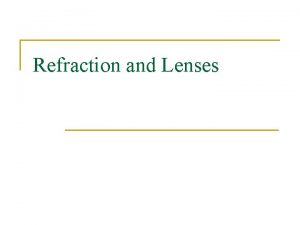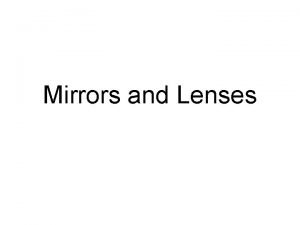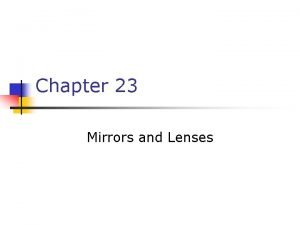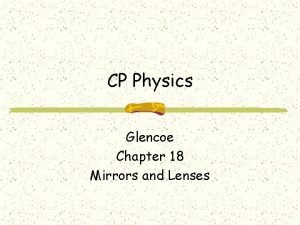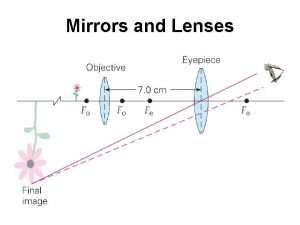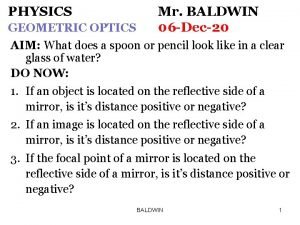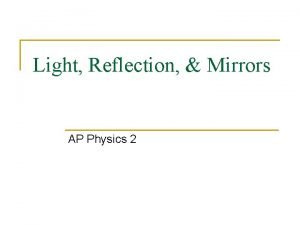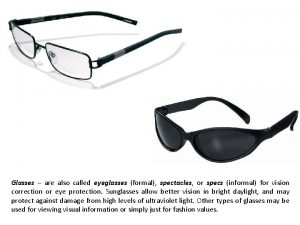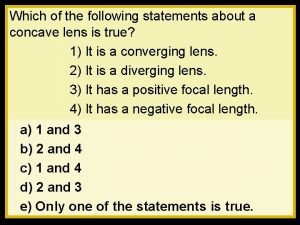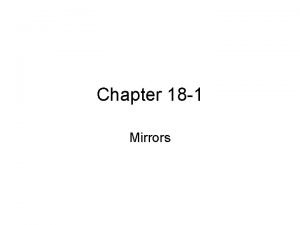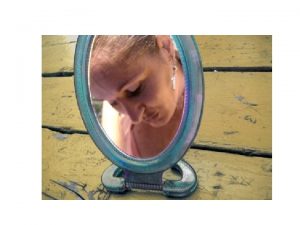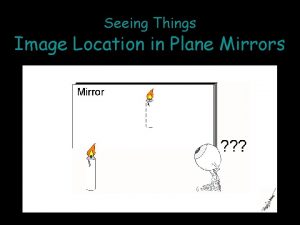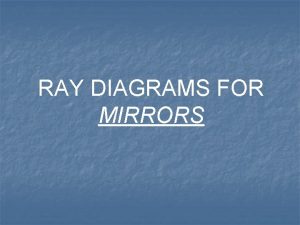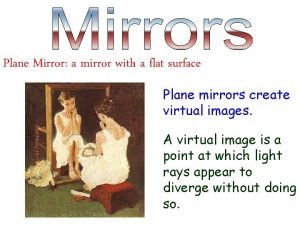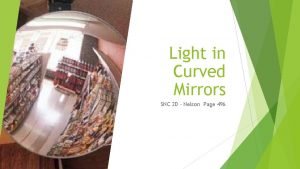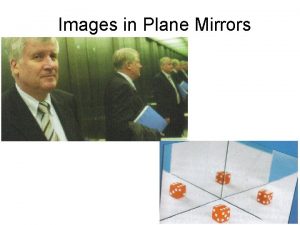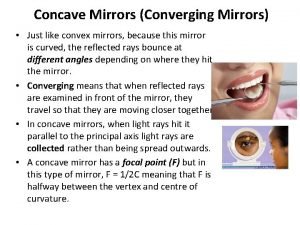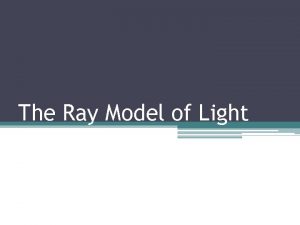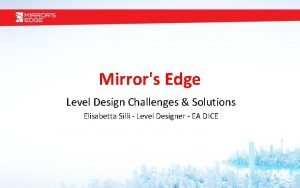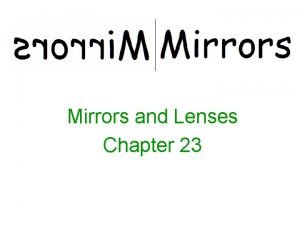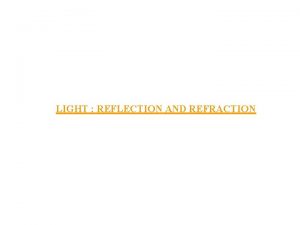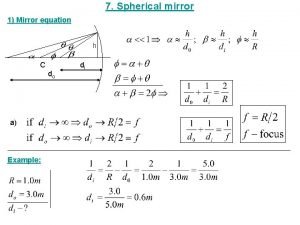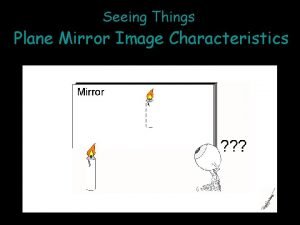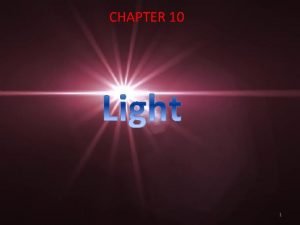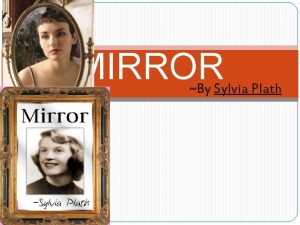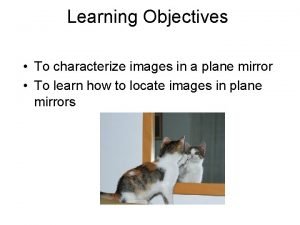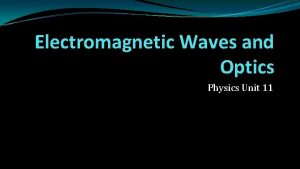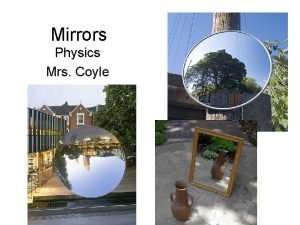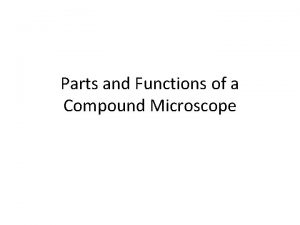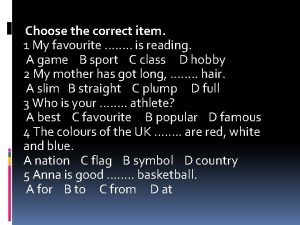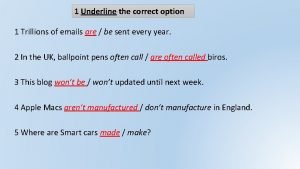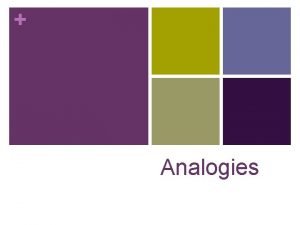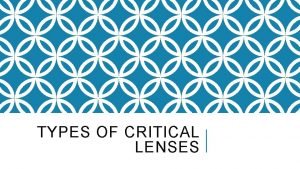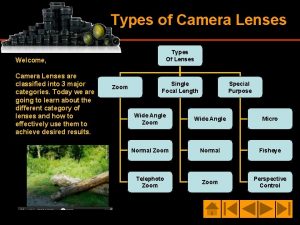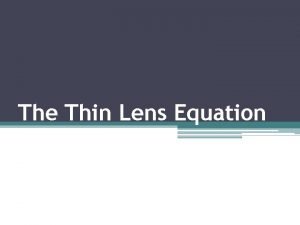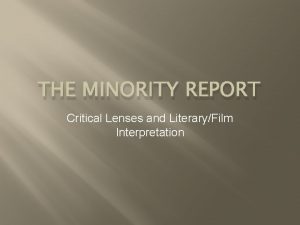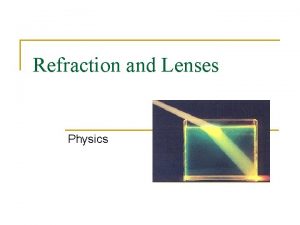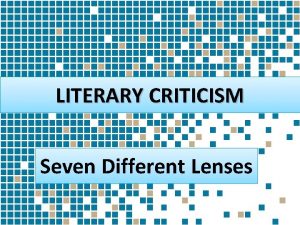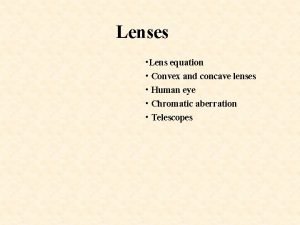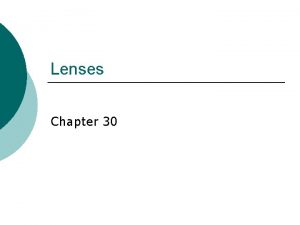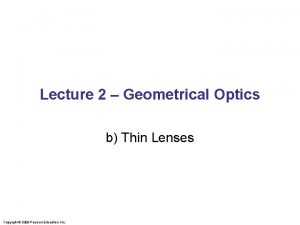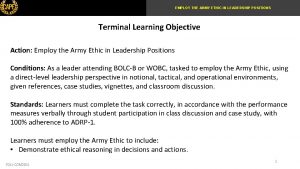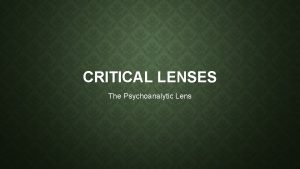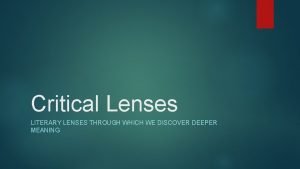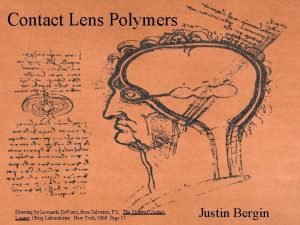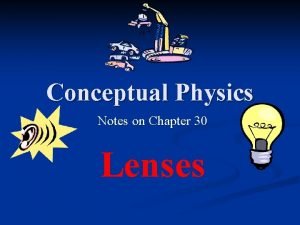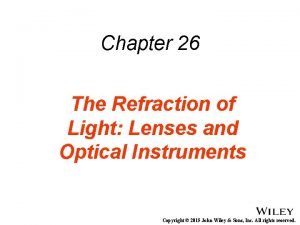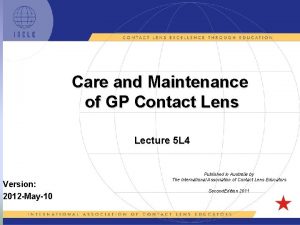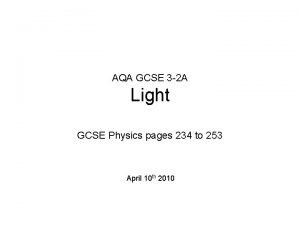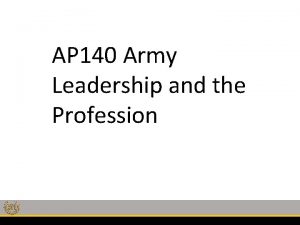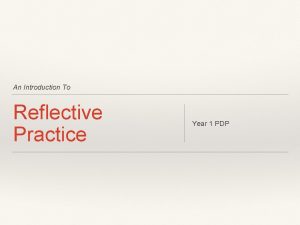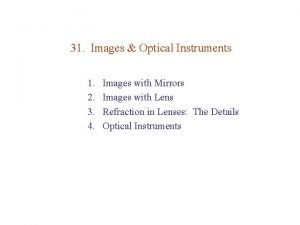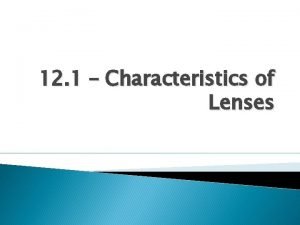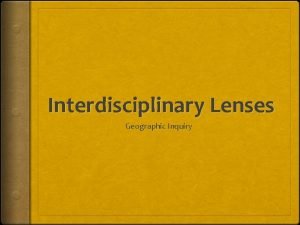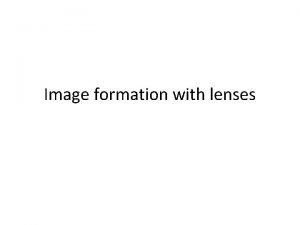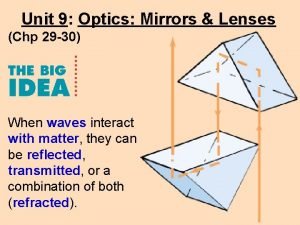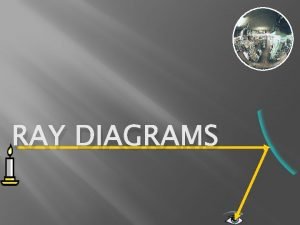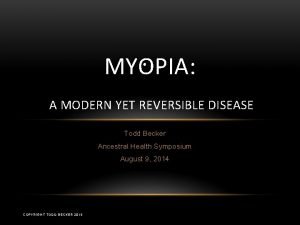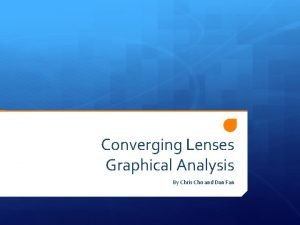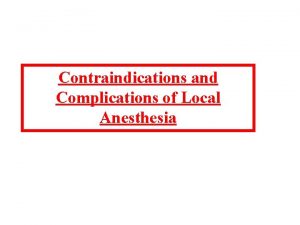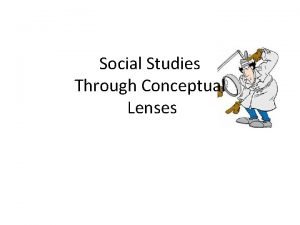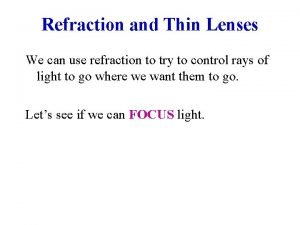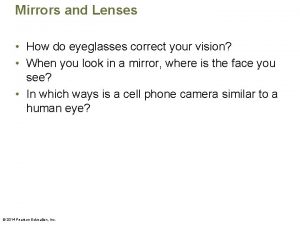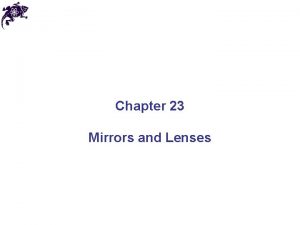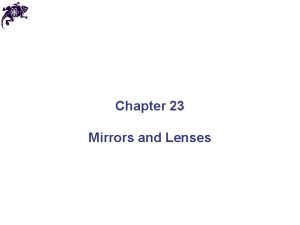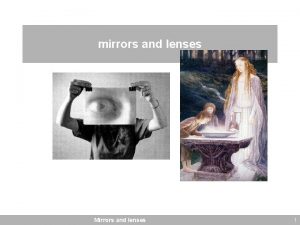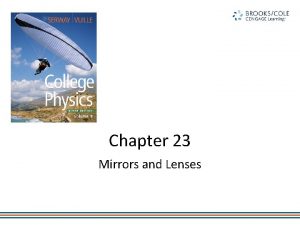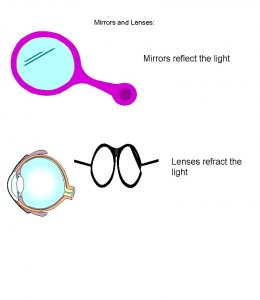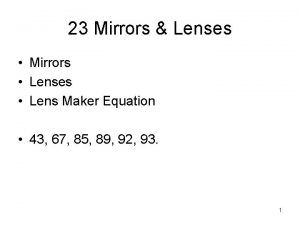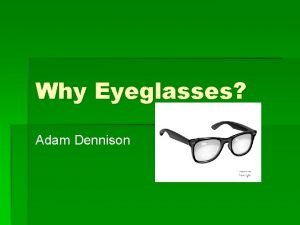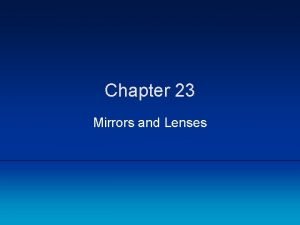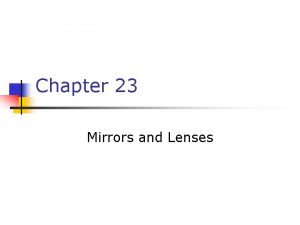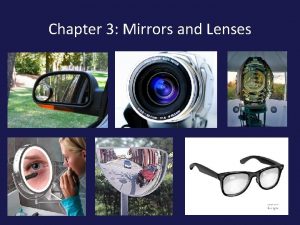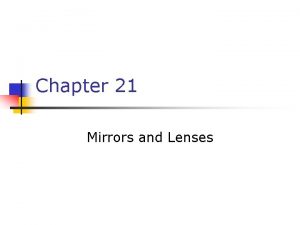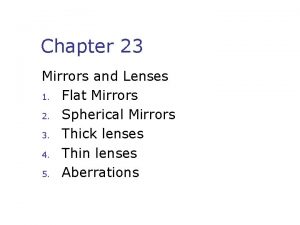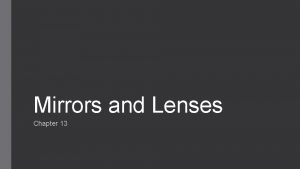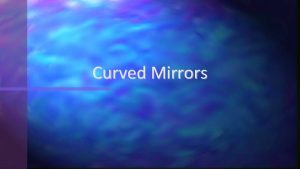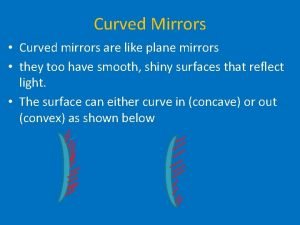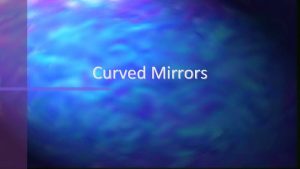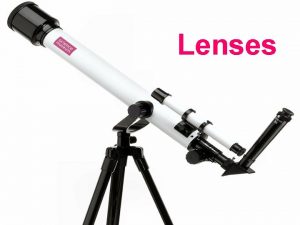Mirrors and Lenses How do eyeglasses correct your














































































- Slides: 78

Mirrors and Lenses • How do eyeglasses correct your vision? • When you look in a mirror, where is the face you see? • In which ways is a cell phone camera similar to a human eye? © 2014 Pearson Education, Inc.

Be sure you know how to: • Apply the properties of similar triangles (Math Review Appendix). • Draw ray diagrams and normal lines (Sections 21. 1, 21. 2, and 21. 3). • Use the laws of reflection and refraction (Sections 21. 2 and 21. 3). © 2014 Pearson Education, Inc.

What's new in this chapter • In this chapter we will apply what we have learned about reflection and refraction to mirrors and lenses. • In the process, we will learn how cameras, telescopes, microscopes, human vision, and corrective lenses work. © 2014 Pearson Education, Inc.

Plane mirrors • The simplest mirror is a plane mirror—a flat, reflective surface, often consisting of a metal film covered in glass. © 2014 Pearson Education, Inc.

Seeing light from an object © 2014 Pearson Education, Inc.

Observational experiment © 2014 Pearson Education, Inc.

Plane mirrors • The image of the real object seen in the mirror is located where light reflected from the mirror to the eye of the observer seems to originate. – This perceived image is behind the mirror and not on the surface of the mirror. • Using the ray diagram, we find that the image is exactly the same distance behind the plane mirror as the object is in front of it. © 2014 Pearson Education, Inc.

Testing experiment © 2014 Pearson Education, Inc.

Testing experiment © 2014 Pearson Education, Inc.

Plane mirror virtual image © 2014 Pearson Education, Inc.

Conceptual Exercise 22. 1 • You place a lamp in front of a mirror and tilt it so that the top and the bottom of the lamp are at different distances from the mirror, at the position shown. Where do you see the image of the lamp produced by the mirror? © 2014 Pearson Education, Inc.

Qualitative analysis of curved mirrors • A curved mirror is cut from a spherically shaped piece of glass backed by a metal film. © 2014 Pearson Education, Inc.

Concave mirrors • Concave mirrors are often used for magnification, in both telescopes and cosmetic mirrors. © 2014 Pearson Education, Inc.

Convex mirrors • Convex mirrors are used as passenger- side rearview mirrors and to provide visibility at blind spots, such as hallway corners and driveway exits. © 2014 Pearson Education, Inc.

Observational experiment © 2014 Pearson Education, Inc.

Observational experiment © 2014 Pearson Education, Inc.

Observational experiment © 2014 Pearson Education, Inc.

Concave mirrors • Concave mirrors cause parallel incident rays to pass through a single point after reflection. – If the incident rays are also parallel to the principal axis, this point is called the focal point F of the mirror. © 2014 Pearson Education, Inc.

Tip © 2014 Pearson Education, Inc.

Focal point of a concave mirror • If a mirror has a large radius of curvature compared to its size and the incident rays are close to the principal axis, the focal point is approximately halfway between the center of the mirror and the center of curvature. © 2014 Pearson Education, Inc.

Reasoning Skill: Constructing a ray diagram to locate the image of an object produced by a concave mirror © 2014 Pearson Education, Inc.

Tip © 2014 Pearson Education, Inc.

Creating a virtual image with a concave mirror © 2014 Pearson Education, Inc.

Locating the image of the base of an object produced by a concave mirror • The image of the base of the object is always on the principal axis directly below the image of the top of the object. © 2014 Pearson Education, Inc.

Convex mirrors • With a convex mirror, rays parallel to the principal axis diverge after reflection from the virtual focal point F behind the mirror. © 2014 Pearson Education, Inc.

Reasoning Skill: Constructing a ray diagram to locate the image produced by a convex mirror © 2014 Pearson Education, Inc.

Conceptual Exercise 22. 3 • You hold a convex mirror 0. 7 R behind a pencil. A. Approximately where is the image of the pencil? B. What are the properties of the image? © 2014 Pearson Education, Inc.

The mirror equation © 2014 Pearson Education, Inc.

© 2014 Pearson Education, Inc.

Objects far away from the mirror • If an object is extremely far away along the principal axis, we can assume that rays from the object reaching the mirror are parallel to the principal axis. © 2014 Pearson Education, Inc.

Example 22. 4 • You place a candle 0. 80 m from a concave mirror with a radius of curvature of 0. 60 m. Where should you place a paper screen to see a sharp image of the candle? © 2014 Pearson Education, Inc.

Example 22. 5 • A friend's face is 0. 60 m from a convex mirror with a 0. 50 -m radius. Where does the image of her face appear to you when you look at the mirror? © 2014 Pearson Education, Inc.

Mirror equation © 2014 Pearson Education, Inc.

Magnification • The change in the size of the image compared to the size of the object is a quantity called linear magnification m: © 2014 Pearson Education, Inc.

Linear magnification © 2014 Pearson Education, Inc.

Example 22. 6 • You use a concave mirror with a radius of curvature of 0. 32 m for putting on makeup or shaving. When your face is 0. 08 m from the mirror, what are the image size and magnification of a 0. 0030 -m-diameter birthmark on your face? © 2014 Pearson Education, Inc.

Tip © 2014 Pearson Education, Inc.

Qualitative analysis of lenses • A lens is a piece of glass or other transparent material with two curved surfaces that produces images of objects by changing the direction of light through refraction. © 2014 Pearson Education, Inc.

Observational experiment © 2014 Pearson Education, Inc.

Observational experiment © 2014 Pearson Education, Inc.

Convex lenses • A convex lens made of glass is similar to a concave mirror where incident rays parallel to the principal axis intersect at a focal point after passing through the lens. – How the rays converge depends on the curvature of the surface of the lens. © 2014 Pearson Education, Inc.

Tip © 2014 Pearson Education, Inc.

Convex lenses with water © 2014 Pearson Education, Inc.

Reasoning Skill: Constructing ray diagrams for single-lens situations: Convex lens © 2014 Pearson Education, Inc.

Reasoning Skill: Constructing ray diagrams for single-lens situations: Concave lens © 2014 Pearson Education, Inc.

Concave lenses • For concave lenses, light seems to diverge from a single point on the axis—the virtual focal point. © 2014 Pearson Education, Inc.

Ray diagrams for various lenses © 2014 Pearson Education, Inc.

Ray diagrams for various lenses © 2014 Pearson Education, Inc.

Image location of the base of the object • The image of the base of the object is directly beneath on the principal axis. © 2014 Pearson Education, Inc.

Conceptual Exercise 22. 8 • Imagine that you have an object, a lens, and a screen. You place an object at a position s > 2 f from the lens and cover the top half of the lens. Half of the object is above the principal axis; half is below this axis. Which part of the image will you see on the screen: the top or the bottom? © 2014 Pearson Education, Inc.

Thin lens equation and quantitative analysis of lenses • A thin lens has a radii of curvature much larger than the size of the lens. © 2014 Pearson Education, Inc.

Thin lenses © 2014 Pearson Education, Inc.

Tip © 2014 Pearson Education, Inc.

Seeing a sharp image on a screen • A screen must be placed where the image is located to view a sharp image. © 2014 Pearson Education, Inc.

Tip © 2014 Pearson Education, Inc.

Linear magnification in lenses • Lenses can produce images that are larger or smaller in size than the original objects. © 2014 Pearson Education, Inc.

Example 22. 10 • You use a convex lens of focal length +10. 0 cm to look at a tiny insect on a book page. The lens is 5. 0 cm from the paper. A. Where is the image of the insect? B. If the insect is 1. 0 cm in size, how large is the image? © 2014 Pearson Education, Inc.

Skills for analyzing processes involving mirrors and lenses • When problem solving: – Assume the lens/mirror is only slightly curved and the rays are incident near the principal axis. – Draw a ray diagram representing the situation in the problem. – Use the picture and ray diagram to help construct a mathematical description of the situation. © 2014 Pearson Education, Inc.

Photography and cameras • Light from an object enters the camera through the lens, which focuses the light on a surface that has light-sensitive properties (an image sensor). © 2014 Pearson Education, Inc.

Light field photography • In light field photography, the image sensor records all the light entering the camera, not just the light that would produce a sharp image on the focal plane. – A photographer can choose an object to focus on after the picture has been taken, because the camera effectively focuses on all objects at once. © 2014 Pearson Education, Inc.

Optics of the human eye • Light from an object enters the cornea and passes through a transparent lens. • An iris in front of the lens widens or narrows, like the aperture on a camera that regulates the amount of light entering the device. • The retina plays the role of the film. © 2014 Pearson Education, Inc.

Optics of the human eye • When the eye looks at distant objects, muscles around the lens of the eye relax, and the lens becomes less curved. • As the object moves closer, the eye muscles contract, increasing the curvature of the lens and reducing the focal length. © 2014 Pearson Education, Inc.

Corrective lenses • The two most common vision abnormalities corrected with lenses are myopia (nearsightedness) and hyperopia (farsightedness). © 2014 Pearson Education, Inc.

Corrective lenses (Cont'd) © 2014 Pearson Education, Inc.

Example 22. 13 • Alex is near-sighted and his far point is 2. 0 m from his eyes. What should the focal length of his eyeglass lens be so that Alex can focus on a very distant object? © 2014 Pearson Education, Inc.

Tip © 2014 Pearson Education, Inc.

Example 22. 14 • Eugenia is far-sighted with a near point of 1. 5 m. If you were an optometrist, which glasses would you prescribe for her so she can read a book held 25 cm from her eyes? © 2014 Pearson Education, Inc.

Angular magnification and magnifying glasses • The impression of an object's size is quantified by its angular size: © 2014 Pearson Education, Inc.

Angular magnification • The angular magnification M of an optical system is defined as: © 2014 Pearson Education, Inc.

Angular size of the object as seen with the unaided eye • The maximum angular size of an object viewed by the unaided eye is: © 2014 Pearson Education, Inc.

Finding the image produced by multiple lenses © 2014 Pearson Education, Inc.

Telescopes • A common telescope has two convex lenses separated by a distance slightly less than the sum of their focal lengths. © 2014 Pearson Education, Inc.

Example 22. 15 • A 1. 2 -m-tall lion stands 50 m from the first lens of a telescope. A. Locate the final image of the lion. B. Determine the linear magnification, height, and angular magnification of the final image. © 2014 Pearson Education, Inc.

The compound microscope © 2014 Pearson Education, Inc.

Summary © 2014 Pearson Education, Inc.

Summary © 2014 Pearson Education, Inc.

Summary © 2014 Pearson Education, Inc.

Summary © 2014 Pearson Education, Inc.
 Refraction in lenses
Refraction in lenses Mirrors and lenses
Mirrors and lenses Sign convention of mirror
Sign convention of mirror Physics classroom lenses and mirrors
Physics classroom lenses and mirrors Types of mirrors and lenses
Types of mirrors and lenses Sign convention for lenses in tabular form
Sign convention for lenses in tabular form Ap physics 2 mirrors and lenses
Ap physics 2 mirrors and lenses Formal spectacles
Formal spectacles If a laboratory fire erupts, immediately
If a laboratory fire erupts, immediately Which statement about concave lenses is true?
Which statement about concave lenses is true? Chapter 17 reflection and mirrors
Chapter 17 reflection and mirrors It is a flat smooth mirror
It is a flat smooth mirror Reflection and mirrors ppt
Reflection and mirrors ppt Give us your hungry your tired your poor
Give us your hungry your tired your poor Flat plate collector with adjustable mirrors
Flat plate collector with adjustable mirrors Plane mirror location
Plane mirror location Ray diagrams for mirrors
Ray diagrams for mirrors Type of mirror with a flat surface
Type of mirror with a flat surface Curved mirrors worksheet
Curved mirrors worksheet Optics salt acronym
Optics salt acronym Salt converging lens
Salt converging lens Light ray model
Light ray model Elisabetta silli
Elisabetta silli Concave mirrors can produce
Concave mirrors can produce Image formed by convex mirror
Image formed by convex mirror Mirror formula
Mirror formula Nd yag laser mirrors
Nd yag laser mirrors Synchronous adjustment mirrors
Synchronous adjustment mirrors Attitude of image in plane mirror
Attitude of image in plane mirror Take a large shining spoon
Take a large shining spoon Fluffy sky mirror reviews
Fluffy sky mirror reviews Mirror by sylvia plath tone
Mirror by sylvia plath tone All images in plane mirrors are apex
All images in plane mirrors are apex Physics 11-06 image formation by mirrors
Physics 11-06 image formation by mirrors Vertical plane mirror
Vertical plane mirror Function of mechanical parts in microscope
Function of mechanical parts in microscope Ideal and actual self example
Ideal and actual self example Read and answer. write in your notebook
Read and answer. write in your notebook In your notebook write questions
In your notebook write questions Choose the correct class item
Choose the correct class item Underline the correct option.
Underline the correct option. Underline the correct option is this you your
Underline the correct option is this you your Write answer to the questions in your notebook
Write answer to the questions in your notebook Write the correct words in your notebook
Write the correct words in your notebook In your notebook write the question
In your notebook write the question Critical lens terminology
Critical lens terminology Types of camera lenses
Types of camera lenses Thin lens equation height
Thin lens equation height Literary critical lenses
Literary critical lenses Physics of lenses
Physics of lenses Archetypal criticism questions
Archetypal criticism questions Ecocriticism in literature
Ecocriticism in literature Lens sign convention
Lens sign convention Chapter 30 lenses
Chapter 30 lenses Converging lens equation
Converging lens equation Literary lenses examples
Literary lenses examples Ethical lens of the ethical reasoning model
Ethical lens of the ethical reasoning model Psychoanalytic lense
Psychoanalytic lense Literature lenses
Literature lenses Lit crit lenses
Lit crit lenses Leonardo da vinci contact lenses
Leonardo da vinci contact lenses Chapter 30 conceptual physics
Chapter 30 conceptual physics Refraction of light in lenses
Refraction of light in lenses Wettability of contact lenses
Wettability of contact lenses Lenses bbc bitesize
Lenses bbc bitesize Army ethical reasoning model
Army ethical reasoning model Brookfields lenses reflective model
Brookfields lenses reflective model Sign convention for lenses in tabular form
Sign convention for lenses in tabular form Characteristics of lenses
Characteristics of lenses Interdisciplinary lenses
Interdisciplinary lenses The principle involved in the image formation by lenses
The principle involved in the image formation by lenses The action of lenses depends mainly on
The action of lenses depends mainly on Bionic contact lens
Bionic contact lens Concave lens examples
Concave lens examples Wink optometrist
Wink optometrist Lenses graph analysis
Lenses graph analysis Anesthesia lenses
Anesthesia lenses 5 lenses of social studies
5 lenses of social studies What kind of shape is this?
What kind of shape is this?
